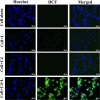Graphene-Based Nanomaterials in Photodynamic Therapy: Synthesis Strategies, Functional Roles, and Clinical Translation for Tumor Treatment
- PMID: 40599400
- PMCID: PMC12212357
- DOI: 10.2147/IJN.S516606
Graphene-Based Nanomaterials in Photodynamic Therapy: Synthesis Strategies, Functional Roles, and Clinical Translation for Tumor Treatment
Abstract
Photodynamic therapy (PDT) is an effective approach for inducing tumor cell death through reactive oxygen species (ROS) generated by light-activated photosensitizers (PSs). Despite its selectivity in tumor treatment, PDT still faces significant challenges in targeting deep-seated tumors due to limitations in tissue penetration and precise localization. Graphene-based nanomaterials, such as graphene oxide (GO), reduced graphene oxide (rGO), graphene quantum dots (GQDs), and graphene nanosheets (GNS), offer innovative solutions by enhancing light penetration, boosting PS activity, and improving tumor-targeting precision. This review highlights how graphene-based nanomaterials address these challenges through functionalization strategies, including receptor-mediated tumor targeting, size-dependent penetration, optical synergy, and hypoxia modulation. Additionally, it explores the synthesis and production challenges associated with these materials. Focusing on four key graphene derivatives-GO, rGO, GQDs, and GNS-this article examines how reaction conditions, catalyst types, and precursor purity influence their structural properties and functional performance in PDT. To facilitate the translation from laboratory research to clinical application, strategies for scaling up production are discussed, emphasizing the need to simplify synthesis processes and improve efficiency for broader biomedical use. This review provides valuable insights into advancing graphene-based nanomaterials for clinical PDT applications, bridging the gap between nanomaterial design and therapeutic precision.
Keywords: functionalization strategies; graphene-based nanomaterials; photodynamic therapy; targeting; tumor therapy.
© 2025 Liang et al.
Conflict of interest statement
The authors declare that they have no known competing financial interests or personal relationships that could have appeared to influence the work reported in this paper.
Figures













Similar articles
-
Innovative approaches for cancer treatment: graphene quantum dots for photodynamic and photothermal therapies.J Mater Chem B. 2024 May 8;12(18):4307-4334. doi: 10.1039/d4tb00255e. J Mater Chem B. 2024. PMID: 38595268 Review.
-
The safety and efficiency of photodynamic therapy for the treatment of osteosarcoma: A systematic review of in vitro experiment and animal model reports.Photodiagnosis Photodyn Ther. 2022 Dec;40:103093. doi: 10.1016/j.pdpdt.2022.103093. Epub 2022 Aug 27. Photodiagnosis Photodyn Ther. 2022. PMID: 36031143
-
Carbon dots as a novel photosensitizer for photodynamic therapy of cancer and bacterial infectious diseases: recent advances.J Nanobiotechnology. 2024 Apr 26;22(1):210. doi: 10.1186/s12951-024-02479-4. J Nanobiotechnology. 2024. PMID: 38671474 Free PMC article. Review.
-
Application of photodynamic activation of prodrugs combined with phototherapy in tumor treatment.Mol Cancer. 2025 Jul 21;24(1):200. doi: 10.1186/s12943-025-02404-9. Mol Cancer. 2025. PMID: 40685358 Free PMC article. Review.
-
Nanoparticle-Mediated Cuproptosis and Photodynamic Synergistic Strategy: A Novel Horizon for Cancer Therapy.Cancer Med. 2025 Feb;14(3):e70599. doi: 10.1002/cam4.70599. Cancer Med. 2025. PMID: 39868904 Free PMC article. Review.
References
Publication types
MeSH terms
Substances
LinkOut - more resources
Full Text Sources
Medical
Miscellaneous

